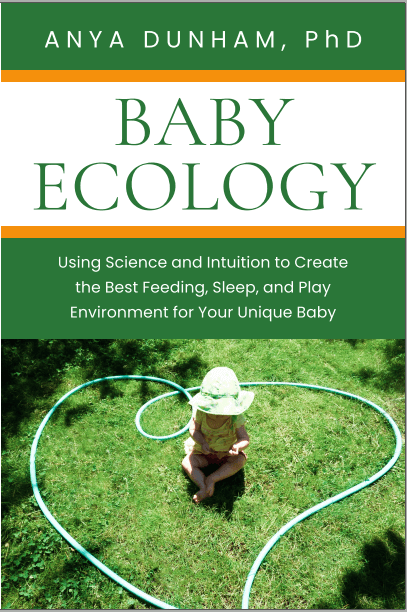Baby Ecology book is here! Learn more
Baby Ecology book is here!
- Home
- Baby-led feeding
- Readiness for solids
- Food before one
Food before one is NOT just for fun
by Anya Dunham, PhD
Food before one is for allergen exposure, flavor, texture, and iron!

"Food before one is just for fun" may be said with seemingly good intentions — to promote longer breastfeeding and to reassure parents — but it's not entirely true.
This is a good example of what I call 'parent pacifying': bending best practices to ‘help’ tired and stressed parents 'feel better' - but it's not actually helpful.
"Food before one is just for fun" is not true
The advice on when to introduce solid foods varies across countries, but it generally falls somewhere between 4 and 6 months. At the time I write this, the World Health Organization recommends that “infants start receiving complementary foods at six months of age in addition to breast milk.”
This is because after ~6 months, babies need extra nutrients, especially iron (and even more so if they are fed breast milk). By then they’ve depleted the iron stores they had at birth, but their their needs are still high due to rapid growth. 1-4 Babies also benefit from early exposure to a variety of textures and tastes 5-9 and from early exposure to common allergens. 10-11
Q: My baby isn't taking to solids easily. What can I do?
🥑 Don't stress if you end up with a not-much-solids-eaten day as long as your baby is receiving enough breast milk or formula. However, keep offering solids every day, a couple of times a day. A baby who wasn't fully ready yesterday may be ready today.
🥑 Keep offering different textures, including purees. Hard-stance BLW ("No purees ever!") isn't supported by research. We all eat purees as adults, right? What matters is that feeding is truly responsive and baby-led.
🥑 Keep offering different flavors AND keep offering the same ones. Your baby might need 8+ tastes of a new food, in different meals, in a supportive, no-pressure setting, before they accept (and often begin to like) the new flavor. Babies are born capable of eating well and eating to appetite, but to retain these capabilities and continue tuning into their sensations as they grow, they need us to support them along the way.
🥑 Eat with your baby and model enjoyment of food and time together. Your baby is learning a lot through the positive, repeated experiences with healthy foods and by seeing others — and especially you — enjoy eating. Share meals with your baby whenever possible to model healthy, happy eating. Eating together will take longer than eating on your own, of course; plan for this and try to enjoy the process as much as the outcome.
More resources
For a comprehensive yet concise look into the studies on introducing solids, I highly recommend Chapter 10 in "The Science of Mom" by Allice Callahan. Other chapters in this book are also fantastic.
My book, Baby Ecology, has a section on Feeding (in addition to Getting Ready for Baby, Sleep, and Care and Play sections).
Last but not least, take a look at the References section below.
Happy eating and feeding!
Select references
Select references
1. Krebs NF et al (2013) Effects of different complementary feeding regimens on iron status and enteric microbiota in breastfed infants. The Journal of Pediatrics 163(2): 416-423.e4
2. Dube K et al (2010) Iron intake and iron status in breastfed infants during the first year of life. Clinical Nutrition 29(6): 773-778
3. Grimes CA et al (2015) Food sources of total energy and nutrients among U.S. infants and toddlers: National Health and Nutrition Examination Survey 2005—2012. Nutrients 7(8): 6797-6836
4. Davidsson L (2003) Approaches to improve iron bioavailability from complementary foods. The Journal of Nutrition 133(5): 1560S-1562S
5. Hausner H et al (2010) Breastfeeding facilitates acceptance of a novel dietary flavour compound. Clinical Nutrition 29(1): 141-148
6. Nicklaus S (2011) Children's acceptance of new foods at weaning. Role of practices of weaning and of food sensory properties. Appetite 57(3): 812-825
7. Maier A et al (2007) Effects of repeated exposure on acceptance of initially disliked vegetables in 7-month old infants. Food Quality and Preference 18(8): 1023-1032
8. Gerrish CJ, Mennella JA (2001) Flavor variety enhances food acceptance in formula-fed infants. The American Journal of Clinical Nutrition 73(6): 1080-1085
9. Mennella JA et al (2008) Variety is the spice of life: strategies for promoting fruit and vegetable acceptance during infancy. Physiology and Behavior 94(1): 29-38
10. Hicke-Roberts A et al (2020) Late introduction of solids into infants’ diets may increase the risk of food allergy development. BMC Pediatrics 20: 273
11. Trogen B et al (2022) Early introduction of allergenic foods and the prevention of food allergy. Nutrients 14(13): 2565
Using hundreds of scientific studies, Baby Ecology connects the dots to help you create the best environment for sleep, feeding, care, and play for your baby.
Warmly,
Anya


